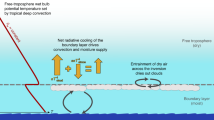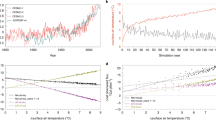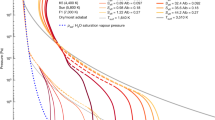Abstract
The increase in solar luminosity over geological timescales should warm the Earth’s climate, increasing water evaporation, which will in turn enhance the atmospheric greenhouse effect. Above a certain critical insolation, this destabilizing greenhouse feedback can ‘run away’ until the oceans have completely evaporated1,2,3,4. Through increases in stratospheric humidity, warming may also cause evaporative loss of the oceans to space before the runaway greenhouse state occurs5,6. The critical insolation thresholds for these processes, however, remain uncertain because they have so far been evaluated using one-dimensional models that cannot account for the dynamical and cloud feedback effects that are key stabilizing features of the Earth’s climate. Here we use a three-dimensional global climate model to show that the insolation threshold for the runaway greenhouse state to occur is about 375 W m−2, which is significantly higher than previously thought6,7. Our model is specifically developed to quantify the climate response of Earth-like planets to increased insolation in hot and extremely moist atmospheres. In contrast with previous studies, we find that clouds have a destabilizing feedback effect on the long-term warming. However, subsident, unsaturated regions created by the Hadley circulation have a stabilizing effect that is strong enough to shift the runaway greenhouse limit to higher values of insolation than are inferred from one-dimensional models. Furthermore, because of wavelength-dependent radiative effects, the stratosphere remains sufficiently cold and dry to hamper the escape of atmospheric water, even at large fluxes. This has strong implications for the possibility of liquid water existing on Venus early in its history, and extends the size of the habitable zone around other stars.
This is a preview of subscription content, access via your institution
Access options
Subscribe to this journal
Receive 51 print issues and online access
$199.00 per year
only $3.90 per issue
Buy this article
- Purchase on Springer Link
- Instant access to full article PDF
Prices may be subject to local taxes which are calculated during checkout




Similar content being viewed by others
References
Simpson, G. C. Some studies in terrestrial radiation. Mem. R. Meteorol. Soc. 11, 69–95 (1927)
Komabayashi, M. Discrete equilibrium temperatures of a hypothetical planet with the atmosphere and the hydrosphere of one component-two phase system under constant solar radiation. J. Meteorol. Soc. Jpn 45, 137–138 (1967)
Ingersoll, A. P. The runaway greenhouse: a history of water on Venus. J. Atmos. Sci. 26, 1191–1198 (1969)
Kasting, J. F., Pollack, J. B. & Ackerman, T. P. Response of Earth’s atmosphere to increases in solar flux and implications for loss of water from Venus. Icarus 57, 335–355 (1984)
Kasting, J. F. Runaway and moist greenhouse atmospheres and the evolution of Earth and Venus. Icarus 74, 472–494 (1988)
Kopparapu, R. K. et al. Habitable zones around main-sequence stars: new estimates. Astrophys. J. 765, 131 (2013)
Goldblatt, C., Robinson, T. D., Zahnle, K. J. & Crisp, D. Low simulated radiation limit for runaway greenhouse climates. Nature Geosci. 6, 661–667 (2013)
Goldblatt, C. & Watson, A. J. The runaway greenhouse: implications for future climate change, geoengineering and planetary atmospheres. Phil. Trans. R. Soc. Lond. A 370, 4197–4216 (2012)
Nakajima, S., Hayashi, Y.-Y. & Abe, Y. A study on the ‘runaway greenhouse effect’ with a one-dimensional radiative-convective equilibrium model. J. Atmos. Sci. 49, 2256–2266 (1992)
Wordsworth, R. D. et al. Gliese 581d is the first discovered terrestrial-mass exoplanet in the habitable zone. Astrophys. J. 733, L48 (2011)
Forget, F. et al. 3D modelling of the early Martian climate under a denser CO2 atmosphere: temperatures and CO2 ice clouds. Icarus 222, 81–99 (2013)
Leconte, J. et al. 3D climate modeling of close-in land planets: circulation patterns, climate moist bistability, and habitability. Astron. Astrophys. 554, A69 (2013)
Charnay, B. et al. Exploring the faint young Sun problem and the possible climates of the Archean Earth with a 3D GCM. J. Geophys. Res. 118, 414–431 (2013)
Pierrehumbert, R. T. Principles of Planetary Climate 289–299 (Cambridge Univ. Press, 2010)
Ramanathan, V. et al. Cloud-radiative forcing and climate: results from the Earth radiation budget experiment. Science 243, 57–63 (1989)
Soden, B. J. & Held, I. M. An assessment of climate feedbacks in coupled ocean atmosphere models. J. Clim. 19, 3354–3360 (2006)
Sherwood, S. C. et al. Relative humidity changes in a warmer climate. J. Geophys. Res. 115, D09104 (2010)
Pierrehumbert, R. T. Thermostats, radiator fins, and the local runaway greenhouse. J. Atmos. Sci. 52, 1784–1806 (1995)
Ishiwatari, M., Takehiro, S.-I., Nakajima, K. & Hayashi, Y.-Y. A numerical study on appearance of the runaway greenhouse state of a three-dimensional gray atmosphere. J. Atmos. Sci. 59, 3223–3238 (2002)
Gough, D. O. Solar interior structure and luminosity variations. Sol. Phys. 74, 21–34 (1981)
Arking, A. & Grossman, K. The influence of line shape and band structure on temperatures in planetary atmospheres. J. Atmos. Sci. 29, 937–949 (1972)
Wordsworth, R. & Pierrehumbert, R. T. Water loss from terrestrial planets with CO2-rich atmospheres. Astrophys. J. 778, 154 (2013)
Kasting, J. F., Whitmire, D. P. & Reynolds, R. T. Habitable zones around main sequence stars. Icarus 101, 108–128 (1993)
Pierrehumbert, R. T. A palette of climates for Gliese 581g. Astrophys. J. 726, L8 (2011)
Yang, J., Cowan, N. B. & Abbot, D. S. Stabilizing cloud feedback dramatically expands the habitable zone of tidally locked planets. Astrophys. J. 771, L45 (2013)
Abe, Y., Abe-Ouchi, A., Sleep, N. H. & Zahnle, K. J. Habitable zone limits for dry planets. Astrobiology 11, 443–460 (2011)
Selsis, F., Wordsworth, R. D. & Forget, F. Thermal phase curves of nontransiting terrestrial exoplanets. I. Characterizing atmospheres. Astron. Astrophys. 532, A1 (2011)
Wordsworth, R. et al. Global modelling of the early Martian climate under a denser CO2 atmosphere: water cycle and ice evolution. Icarus 222, 1–19 (2013)
Hourdin, F. et al. The LMDZ4 general circulation model: climate performance and sensitivity to parametrized physics with emphasis on tropical convection. Clim. Dyn. 27, 787–813 (2006)
Mellor, G. L. & Yamada, T. Development of a turbulence closure model for geophysical fluid problems. Rev. Geophys. Space Phys. 20, 851–875 (1982)
Rothman, L. S. et al. The HITRAN 2008 molecular spectroscopic database. J. Quant. Spectrosc. Radiat. Transf. 110, 533–572 (2009)
Clough, S., Kneizys, F. & Davies, R. Line shape and the water vapor continuum. Atmos. Res. 23, 229–241 (1989)
Borysow, A. & Frommhold, L. Collision-induced rototranslational absorption spectra of N2-N2 pairs for temperatures from 50 to 300 K. Astrophys. J. 311, 1043–1057 (1986)
Richard, C. et al. New section of the HITRAN database: collision-induced absorption (CIA). J. Quant. Spectrosc. Radiat. Transf. 113, 1276–1285 (2011)
Toon, O. B., McKay, C. P., Ackerman, T. P. & Santhanam, K. Rapid calculation of radiative heating rates and photodissociation rates in inhomogeneous multiple scattering atmospheres. J. Geophys. Res. 94, 16287–16301 (1989)
Hansen, J. E. & Travis, L. D. Light scattering in planetary atmospheres. Space Sci. Rev. 16, 527–610 (1974)
Bucholtz, A. Rayleigh-scattering calculations for the terrestrial atmosphere. Appl. Opt. 34, 2765–2773 (1995)
Le Treut, H. & Li, Z.-X. Sensitivity of an atmospheric general circulation model to prescribed SST changes: feedback effects associated with the simulation of cloud optical properties. Clim. Dyn. 5, 175–187 (1991)
Manabe, S. & Wetherald, R. T. Thermal equilibrium of the atmosphere with a given distribution of relative humidity. J. Atmos. Sci. 24, 241–259 (1967)
Frierson, D. M. W. The dynamics of idealized convection schemes and their effect on the zonally averaged tropical circulation. J. Atmos. Sci. 64, 1959–1976 (2007)
Boucher, O., Le Treut, H. & Baker, M. B. Precipitation and radiation modeling in a general circulation model: Introduction of cloud microphysical processes. J. Geophys. Res. 100, 16395–16414 (1995)
Forget, F., Hourdin, F. & Talagrand, O. CO2 snowfall on Mars: simulation with a general circulation model. Icarus 131, 302–316 (1998)
Van Leer, B. Towards the ultimate conservative difference scheme: IV. A new approach to numerical convection. J. Comput. Phys. 23, 276–299 (1977)
Le Hir, G., Teitler, Y., Fluteau, F., Donnadieu, Y. & Philippot, P. The faint young Sun problem revisited with a 3-D climate-carbon model - Part 1. Clim. Past Discuss. 9, 1509–1534 (2013)
Wolf, E. & Toon, O. B. Hospitable Archean climates in a general circulation model. Astrobiology 13, 656–673 (2013)
Acknowledgements
We thank our referees, J. Kasting and Y. Abe, for their thorough review, and A. Spiga and F. Selsis for discussions. This work was supported by grants from Région Ile-de-France.
Author information
Authors and Affiliations
Contributions
J.L. developed the ‘high temperature/humidity’ version of the generic global climate model, performed the calculations, and led the analysis and writing of the results. F.F. initiated the development of the generic global climate model and provided critical advice during analysis and writing. B.C. worked on the development of the model and helped perform the comparison with present Earth climatology. R.W. developed the original version of the generic model and implemented the radiative transfer scheme. A.P. performed comparison runs and sensitivity studies. All the authors commented on the manuscript.
Corresponding author
Ethics declarations
Competing interests
The authors declare no competing financial interests.
Extended data figures and tables
Extended Data Figure 1 Validation of the radiative transfer model at high temperature.
Dependence of outgoing thermal radiation (a), Bond albedo (b) and effective solar constant (with respect to the current solar constant; c) on surface temperature with a 1D version of our GCM in the ‘reverse climate modelling’ mode4,6. The dashed curve is the pure-water case, and the solid curve is the case with a 1 bar N2 background atmosphere including 376 p.p.m.v. of CO2. The surface albedo is 0.25.
Extended Data Figure 2 Evolution of the cloud radiative forcing with mean solar incoming flux for the scenario with fixed cloud particle radii.
Solid, dotted and dashed curves are respectively the short-wave, long-wave and net radiative cloud forcing. Although fewer simulations have been run, the changes in the value of the slopes around 353 and 365 W m−2 seem to have the same origin as the behaviour change seen in Fig. 2c (although they occur at different fluxes). These changes in cloud behaviour might be due to the disappearance of both permanent ice caps (at lower fluxes) and seasonal snow cover (at higher fluxes).
Extended Data Figure 3 Comparison between 1D and 3D cloud-free aquaplanet simulations.
a, Mean surface temperature as a function of incoming stellar flux. b, Emitted thermal flux dependence on surface temperature. c, Water-vapour column as a function of surface temperature. In all panels, filled dots stand for the idealized 3D set of aquaplanet simulations, and grey curves stand for the 1D model. In both cases, a uniform surface albedo of 0.22 is used. In the 1D case, three values of relative humidity in the radiative transfer are used: 1 (solid), 0.6 (dashed) and 0.45 (dotted).
Extended Data Figure 4 Relative humidity and radiative budget for an idealized, cloud-free aquaplanet.
a, Annually and zonally averaged relative humidity in a latitude–altitude plane. b, Distributions of absorbed (grey dashed) and emitted (grey dotted) flux and surface temperature (solid black) with latitude (annually and zonally averaged). The red line is the asymptotic-limit infrared flux for a saturated atmosphere. Results are shown for the case with insolation 375 W m−2.
Extended Data Figure 5 Surface albedo map used for the Earth baseline case.
This map does not include the effect of the ice albedo, which is computed directly by the GCM. The albedo of Greenland and Antarctica, in particular, was set to 0.35. The altitude of these regions was, however, left unchanged, explaining in part the temperature contrasts around these areas in Fig. 1.
Rights and permissions
About this article
Cite this article
Leconte, J., Forget, F., Charnay, B. et al. Increased insolation threshold for runaway greenhouse processes on Earth-like planets. Nature 504, 268–271 (2013). https://doi.org/10.1038/nature12827
Received:
Accepted:
Published:
Issue Date:
DOI: https://doi.org/10.1038/nature12827
This article is cited by
-
A cool runaway greenhouse without surface magma ocean
Nature (2023)
-
Ecocentrism and Biosphere Life Extension
Science and Engineering Ethics (2022)
-
Classification and Understanding of Cloud Structures via Satellite Images with EfficientUNet
SN Computer Science (2022)
-
The future lifespan of Earth’s oxygenated atmosphere
Nature Geoscience (2021)
-
A Complex Life Habitable Zone Based On Lipid Solubility Theory
Scientific Reports (2020)
Comments
By submitting a comment you agree to abide by our Terms and Community Guidelines. If you find something abusive or that does not comply with our terms or guidelines please flag it as inappropriate.



